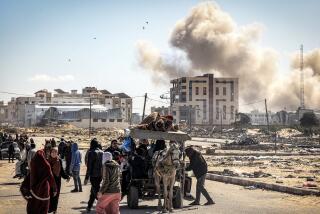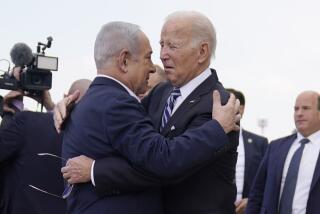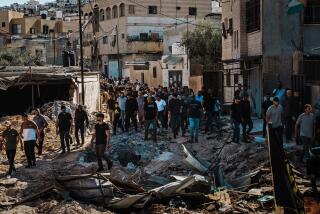Israel and Palestinians have conflicting visions for village’s future
It’s easy to conjure the village that once was, hidden deep in a picturesque valley at the western gateway to Jerusalem, almost buried by blooming almond trees, tangled grapevines and a carpet of yellow wildflowers.
The roofs and window shutters are long gone from the old stone houses, but decorative brickwork around the doorways and broken staircases bears witness to a bygone prosperity.
The freshwater spring was paved over years ago, but the water still gurgles down the main road, just as it did more than 60 years ago.
Homeless addicts sleep in the former mayor’s house and sunlight floods through arched mosque windows, illuminating trash and debris.
They called it Lifta. Today, the abandoned village is the last intact pre-1948 Palestinian town in Israel. Hundreds of similar Palestinian communities were razed after residents fled during Israel’s 1948 war for independence.
For reasons lost to history, Lifta’s homes, cemetery and olive press were left standing, though its farmland was confiscated and is now the site of Israel’s Supreme Court; its parliament, the Knesset; and Hebrew University.
After being forgotten for decades, Lifta is now the focus of conflicting visions of its future, and of its past. Israel wants to develop luxury apartments at the old village, while Palestinians hope to turn the ruins into an open-air museum devoted to their mass displacement in 1948, an event Palestinians call the nakba, or catastrophe.
The ghost town has become an embodiment of one of the most intractable issues in Mideast peace talks: whether Palestinians should have the right to return to ancestral homes inside Israel and what this would mean for Israel’s survival as a Jewish state.
During the creation of Israel and the subsequent attack by neighboring Arab nations, 700,000 Palestinians became refugees when they fled the fighting or were chased from their homes by Jewish militias that prevented them from returning. Some Israelis say Palestinians left voluntarily and therefore gave up rights to their land.
Today those towns exist only as dots on Palestinian maps and in the stories of aging refugees. Though many mosques were preserved, most of the homes, shops and roads were torn down to build Jewish cities. Other villages were turned into forests and parks, which explains why hikers sometimes stumble upon what appear to be abandoned mosques in the middle of nowhere.
The remains of Lifta were swallowed by the expansion of Jerusalem. On one side of the former village, cars speed past on Begin Highway. The canyon below houses a secret military installation, believed to contain an underground bunker for Israeli lawmakers in the event of a nuclear attack. At the top of the hill, bulldozers are clearing land for a high-speed rail line to Tel Aviv.
Hebrew University professor and sociologist Daphna Golan said the dispute over Lifta touches a nerve with many Israelis, who, like many Palestinians, sometimes see the conflict as a zero-sum struggle between dueling narratives. In the minds of some Israelis, acknowledging the Palestinians’ loss competes with their own struggle for statehood, she said.
“It’s hard for people of the older generation, the ones who did this, to accept what happened,” she said. “As time passes and that generation disappears, maybe it will be easier. The question is whether anything will be left.”
Israel’s Lands Administration announced in January that it would begin selling plots of land in Lifta for a project to develop 212 luxury apartments, a hotel and retail shops. The government has given the old Palestinian village a Hebrew name: Mei Naftoah.
Former Lifta residents, many of whom live in East Jerusalem, have joined Israeli conservationists and planners seeking to block the project, arguing that Lifta should be preserved as a historical site.
Opponents recently won a temporary injunction to halt the project.
“This is about our memory, our heritage and our culture,” said Zacharia Odeh, whose parents lived in Lifta until 1948. “Many of us still have the deeds to our homes. But even if we are not allowed to return, it should be preserved.”
Odeh, executive manager of a civil rights coalition in Jerusalem, is helping to organize the effort to save Lifta. He said the housing project, which would probably cater to wealthy American and European Jews, would erase much of the last surviving evidence that Palestinians once occupied much of what is now Israel.
“They are trying to get rid of any signs of refugees and preventing us from keeping any memories for the future, “ said Odeh, who visits his family’s old house on weekends with his children for picnics.
Opponents of the proposed development have appealed for historical recognition by UNESCO and assistance from the U.N. Relief and Works Agency, a Palestinian refugee assistance group, and the Arab League.
Officials at the Lands Administration, the Israeli Interior Ministry and Jerusalem municipality all declined to comment. A spokesman for the mayor of Jerusalem said in a statement that the proposal calls for preserving Lifta’s structures, a contention activists dispute.
Neither Israelis nor Palestinians can claim to be particularly respectful of each other’s histories.
The Knesset last month passed a law that would impose fines on groups or authorities that commemorate the Palestinian displacement.
Many Palestinians still question whether the Holocaust took place, and in the Gaza Strip this month, the Islamist group Hamas moved to prevent U.N. schools there from teaching about the genocide of 6 million European Jews, according to news reports.
Yacoub Odeh, 71, Zacharia’s older brother, was born in Lifta and lived there until he was 8. For him, the struggle over the village’s future is deeply rooted in his past.
“I remember everything about Lifta,” he said, smiling and closing his eyes.
He recalled lazy summer days when he kept cool in the mud around the spring. He said he dreaded the arduous hike up the hill to school each morning, but loved bounding back down, hopping from rock to rock like a cricket. On days off, he’d ride a donkey cart with his older sister to spread cow manure on the family’s farmlands, and gorge on fresh fruit picked from the orchards on the way home.
Those memories would sustain him — like watching a favorite movie — after the family fled Lifta and moved to Ramallah in the West Bank. He said he slept under a tree, begged for food and watched his distraught father, then 35, sink into depression and illness.
As a child, Yacoub understood little about the conflict. One day, the shooting started, and his father ran through a gantlet of gunfire to a waiting truck, carrying his children on his shoulders. His mother threw a blanket over the children in the back, and he remembers peeking out to see speeding jeeps and men in uniforms. The family took nothing expect the house key.
“We thought we were coming back,” he said.
But in late 1947, Lifta became a battleground between Israel’s pre-state militias and Arab fighters. The Jewish militias Haganah and the Stern Gang killed several villagers in two attacks, one against a bus, the other against Lifta’s popular coffeehouse, according to accounts by Israeli historian Ilan Pappe. By early 1948, the entire population of the village was gone.
The Odeh family eventually settled half a mile away in East Jerusalem, which was controlled by Jordan at the time.
After Israel seized East Jerusalem during the 1967 Middle East War, the Odehs were able to visit their old home, which had temporarily housed Jewish immigrants from Yemen and Iraq. The family discovered that the Israeli government had seized legal title to their home under an absentee landownership law passed in the 1950s.
Though the building was vacant, they were not allowed to occupy it.
For Yacoub, the experience was bittersweet. “I was happy to be back, of course, but it’s hard to see it and know that I can’t stay. So here is my house, there’s the spring, the cemetery and the mosque. Yet I can’t live in it.”
Now, he said, the best he can hope for is to save the village from destruction. “This isn’t about stealing a house or land,” he said. “It’s about stealing a life and memories.”
More to Read
Start your day right
Sign up for Essential California for news, features and recommendations from the L.A. Times and beyond in your inbox six days a week.
You may occasionally receive promotional content from the Los Angeles Times.






